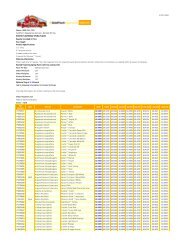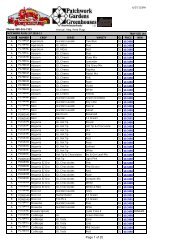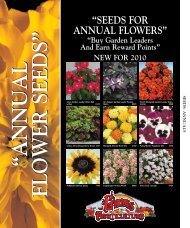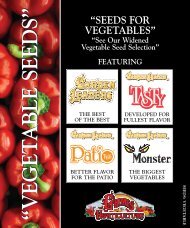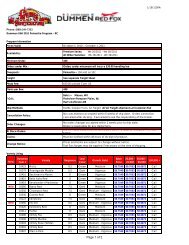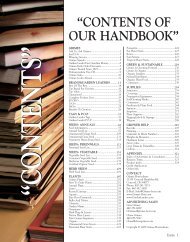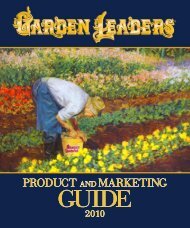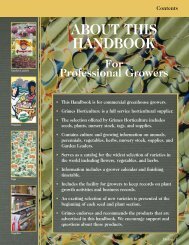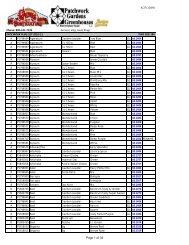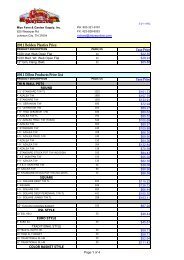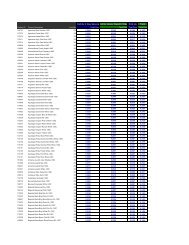Types of Peas The Planting and Culture of Peas Soil and the ...
Types of Peas The Planting and Culture of Peas Soil and the ...
Types of Peas The Planting and Culture of Peas Soil and the ...
Create successful ePaper yourself
Turn your PDF publications into a flip-book with our unique Google optimized e-Paper software.
As <strong>the</strong> plants come up <strong>the</strong>y can be thinned to st<strong>and</strong> two to three inches apart. One pound <strong>of</strong> seed<br />
is enough for a 100-foot row.<br />
High varieties are planted somewhat differently. <strong>The</strong> seed are planted in double rows 30 to 36<br />
inches apart. <strong>The</strong> rows can consist <strong>of</strong> two parallel drills six inches apart, or one trench six inches<br />
wide <strong>and</strong> four inches deep. Plant seed about 21/2 inches apart <strong>and</strong> cover <strong>the</strong>m with enough soil<br />
to half-fill <strong>the</strong> drills or trench. After <strong>the</strong> plants have emerged, finish filling-in <strong>the</strong> rows. Planted in<br />
this way, about one pound <strong>of</strong> seed will plant a double, 100-foot row.<br />
Supporting Pea Plants<br />
No variety <strong>of</strong> peas will amount to much without <strong>the</strong> proper support for <strong>the</strong> plants. <strong>The</strong> best ones<br />
are made <strong>of</strong> brush that has plenty <strong>of</strong> twigs <strong>and</strong> has its bark intact. Placed firmly in <strong>the</strong> ground<br />
between <strong>the</strong> rows, this "brush fence" should st<strong>and</strong> about four or five feet high.<br />
Many gardeners prefer to use a fine-mesh chicken-wire fence instead <strong>of</strong> <strong>the</strong> brush since it may be<br />
used season after season. Wire should be securely fastened to stakes placed at six-foot intervals<br />
down <strong>the</strong> rows. Small-meshed wire is best because it sags less than <strong>the</strong> larger-meshed kind.<br />
Pea Insect Pests <strong>and</strong> Diseases<br />
<strong>The</strong>re are a few common diseases <strong>of</strong> peas. <strong>The</strong>ir severity is usually determined by climatic<br />
conditions. Fungi which cause root rot may destroy <strong>the</strong> entire pea crop. A good control is to rotate<br />
<strong>the</strong> crop with unrelated crops each season. Do not plant peas on low-lying spots where drainage<br />
is poor. <strong>The</strong> same measures are valuable in controlling wilt, bacterial blight <strong>and</strong> anthracnose. If<br />
you are having trouble with damping-<strong>of</strong>f, you may be planting your peas too deeply.<br />
Many kinds <strong>of</strong> insects may attack peas, but only two are serious pests. <strong>The</strong> pea aphid attacks<br />
young vines <strong>and</strong> sucks <strong>the</strong> juices from <strong>the</strong> developing tips. <strong>The</strong> pea weevil infests <strong>the</strong> pods.<br />
Harvesting <strong>Peas</strong><br />
Green peas should be harvested when <strong>the</strong>y are young <strong>and</strong> tender. If left to hang on <strong>the</strong> vines too<br />
long, <strong>the</strong>y become starchy <strong>and</strong> hard. <strong>The</strong>y should be shelled <strong>and</strong> cooked within an hour or so<br />
after picking because in two hours after picking <strong>the</strong> sugar begins to turn to starch. Although still<br />
edible, <strong>the</strong>y are not as sweet.<br />
Tearing or jerking pods from <strong>the</strong> vines injures <strong>the</strong> plants so much that <strong>the</strong>y may stop bearing<br />
pods. Since peas mature rapidly, plan to preserve <strong>the</strong> surplus by canning, or preferably, freezing.<br />
<strong>Peas</strong> can also be dried. Shell <strong>and</strong> blanch for 15 minutes over steam. Dry in <strong>the</strong> sun or use<br />
ano<strong>the</strong>r method <strong>of</strong> drying.<br />
Edible-pod varieties should be harvested when <strong>the</strong> peas are just beginning to form. At this stage,<br />
<strong>the</strong> pea <strong>and</strong> <strong>the</strong> pod are stringless <strong>and</strong> can be eaten toge<strong>the</strong>r. <strong>Peas</strong> alone can be eaten at a later<br />
stage, but <strong>the</strong>y must be picked while still young.<br />
Varieties <strong>of</strong> <strong>Peas</strong><br />
A number <strong>of</strong> pea varieties are available. <strong>The</strong> familiar green peas come in extra-early, dwarf <strong>and</strong><br />
large varieties. Extra Early Alaska is <strong>the</strong> earliest dwarf available; it is hardy, wilt resistant <strong>and</strong><br />
matures uniformly.<br />
Improved Laxton's Progress is an early dwarf that grows to about 16 to 18 inches high <strong>and</strong>



